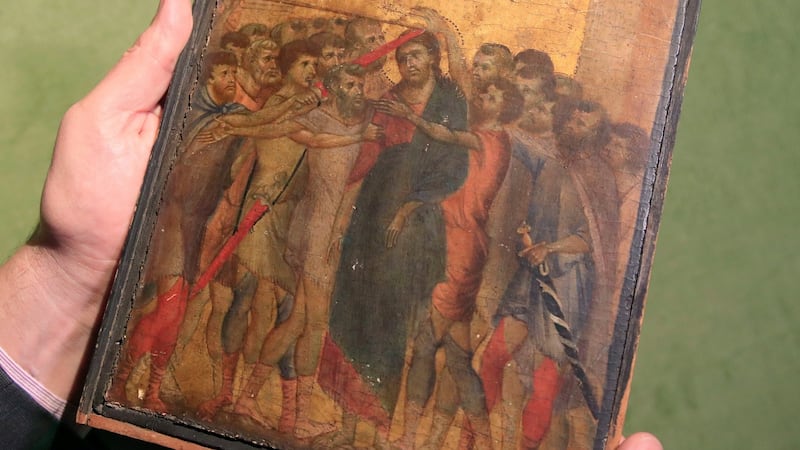A tiny early Renaissance masterpiece found in a French woman’s kitchen during a house clearance has fetched more than €24 million at auction, making it the most expensive medieval painting ever sold.
Christ Mocked, by the 13th-century Florentine painter Cimabue, had hung for decades above a cooking hotplate in the open-plan kitchen of a 1960s house near Compiègne, north of Paris.
It had never attracted much attention from the woman, in her 90s, or her family, who thought it was simply an old icon from Russia. It might have ended up in a bin during the house move this summer had it not been spotted by an auctioneer who had come to value furniture.
At an auction outside Paris on Sunday, the unsigned work, measuring just 26cm by 20cm, fetched €19.5 million under the hammer, rising to over €24 million when fees were included.
The Acteon auction house in Senlis said in a statement the sale was the biggest for a medieval painting and the seventh highest for a medieval or old master painting.
The painting now ranks alongside works by Leonardo da Vinci, Rubens, Rembrandt and Raphael in the top 10 of most expensive old painting sales.
"When a unique work of a painter as rare as Cimabue comes to market, you have to be ready for surprises," said Dominique Le Coent, who heads the Acteon auction house in Senlis. "This is the only Cimabue that has ever come on the market."
As 800 people gathered in the auction hall in Senlis, the crowd fell silent during the nail-biting final moments of bidding. Some bids came in by telephone to agents. As the auctioneer brandished his hammer as the price crept up, he said: “There will never be another Cimabue at auction.”
Acteon did not reveal the identity of the buyer but said a foreign museum had been among the bidders.
The painting had hung on the kitchen wall for so long that the woman, who asked to remain anonymous, told the auction house she had no idea where it had come from or how it had come into the family’s hands.

Cimabue, also known as Cenni di Pepo, was one of the pioneering artists of the early Italian Renaissance. Only 11 works painted on wood have been attributed to him, none of them signed.
Art experts at Turquin in Paris used infrared reflectology to confirm that the piece was part of a larger diptych from 1280, when Cimabue painted eight scenes of the passion and crucifixion of Christ.
Each of the two panels in the diptych had four scenes.
Two scenes from the same diptych, known as The Virgin and Child with Two Angels and The Flagellation of Christ, already hang in the National Gallery in London and the Frick Collection in New York.
Cimabue, who taught the Italian master Giotto, is widely considered the forefather of the Italian Renaissance. He broke from the Byzantine style popular in the Middle Ages and began to incorporate elements of movement and perspective that came to characterise western painting.
The National Gallery described Cimabue’s work as representing “a crucial moment in the history of art” when Italian painters, while still influenced by Byzantine painting, were exploring the naturalistic depiction of forms and three-dimensional space.
In June, when the woman decided to sell her house and move away, an expert at the Senlis auctioneers was contacted to look at the contents of the house in case some of it could be sold.
“I had a week to give an expert view on the house contents and empty it,” Philomène Wolf told Le Parisien last month. “I had to make room in my schedule - if I didn’t, then everything was due to go to the dump.”
Ms Wolf said she noticed the painting as soon as she entered the house. “You rarely see something of such quality. I immediately thought it was a work of Italian primitivism. But I didn’t imagine it was a Cimabue.”
The auctioneer, who began her job at the auction house only last year, suggested that the woman bring the painting to experts for an evaluation. She initially thought there might be a sale price of €300,000 to €400,000, until art expert valued it at millions.
About 100 other objects from the house were sold for around €6,000 and the remaining furniture and decorations were disposed of at the local dump. - Guardian










